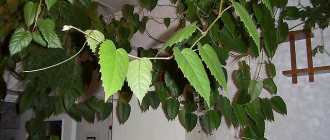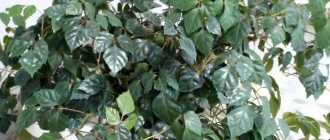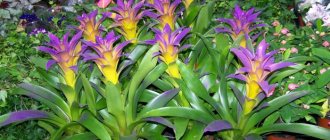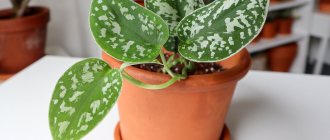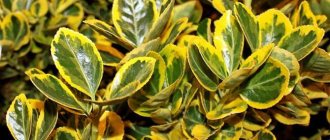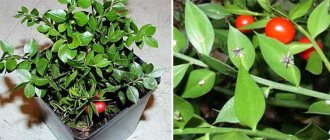Birch, indoor grapes, grape ivy - this is what people call cissus, a magnificent hanging plant that can often be found. It is grown in apartments, offices, shops, and medical institutions. Why is cissus so loved by flower growers? First of all, of course, for its spectacular appearance and bright glossy leaves, reminiscent, depending on the variety, of birch leaves or mini-grapes. Well, secondly, the plant is unpretentious and does not require much effort from gardeners. Let's get to know this wonderful representative of indoor floriculture better.
Cissus belongs to the grape family (lat. Vitaceae), and in the wild it is found in the humid tropics and subtropics of Africa, Asia, Australia and South America. In natural conditions, you can find at least 350 species of cissus, some of which humans have adapted not only for decorative, but also for very practical purposes: as a food product, as a medicine for malaria, for creating hedges, and so on.
The name of the flower comes from the Greek word literally meaning "ivy", indicating the ampelous nature of the plant.
Cissus is an evergreen climbing plant, or rather a creeping shrub with elastic, elastic stems and glossy, rich green leaves, the shape and size of which vary depending on the species. Cissus flowers are collected in pseudo-umbellate inflorescences and are colored cream or greenish-white. In general, flowering is not of decorative interest, and in indoor conditions it almost never occurs. However, in some cases, cissus growing at home can bloom and even bear fruit.
Features of the plant
Cissus is a genus of plants belonging to the Vine family (Vitaceae). The natural habitat of the flower is Africa, Asia, Australia and South America. Cissus grows in tropical or subtropical climates, but now it can be found almost all over the world, because... it grows well indoors. The name of the plant is translated from Greek as “ivy.”
Cissus can be grown as a vine or as a bush. To grow a plant in a pot, you need to put a support in it; when the bush reaches the height of the support, it should be trimmed. After this, the cissus begins to bush.
More often at home, cissus is grown in hanging pots. The liana has tendrils like grapes, they cling to supports to fix themselves.
Cissus grows quite quickly: in 2-3 years the vine reaches a length of 3 m. In addition, it should be borne in mind that if the bush grows in comfortable conditions, its growth accelerates significantly.
Cissus is an evergreen vine. It has a fairly compact rhizome. Flexible shoots can reach a length of 3-3.5 m. Over time, the shoots become woody and covered with gray bark, which cracks and peels off over the years. The stem contains internodes with petiolate leaves and tendrils. Leaf blades can be entire, palmate or lobed. The leaves are glossy, bright green.
Cissus hardly blooms indoors; in nature it blooms in summer. The inflorescences are umbrella-shaped with inconspicuous white flowers. The crown itself is of great value.
The plant feels good in the conditions of central Russia. As it grows, it can cover large areas.
Cissus: can you keep it in the house - useful properties and signs
Thanks to the high bacterial and phytoncidal activity of the indoor flower, the atmosphere in the home is cleansed. Microcomponents released by cissus kill bacteria that cause allergic diseases and gastrointestinal disorders.
Decorative vine perfectly humidifies the air in the room and absorbs excess dust.
Helps get rid of formaldehyde - fumes from building materials, which often cause headaches, provoke nausea, and irritate the respiratory system.
Several pots of plants in the room increase vitality and reduce fatigue.
Popular signs and superstitions associate the cissus flower, like most lianas, with a muzhigon flower, that is, the flower is capable of surviving a spouse from home. Whether or not to keep hanging plants at home is up to everyone to decide for themselves; most flower growers do not pay attention to these myths.
Popular types
The genus includes almost 300 plant species. However, only a small part is suitable for growing at home, in particular: Antarctic, diamond-leaved and multi-colored cissus.
Antarctic cissus (Cissus antarctica)
The plant is popularly called the “Kangaroo liana.” The leaf blade has an oval shape, its length is 5-8 cm. The leaves are dark green, the inside is lighter. There are dark brown hairs on the surface of the branches and shoots. The flowers are collected in inflorescences and painted in a light green shade. The standard length of the vine is 2-2.5 m.
The Antarctic species loves partial shade or shade, needs frequent watering and high humidity.
Cissus rhombifolia
The name is given in honor of the shape of the leaf plate, it resembles a rhombus. Among gardeners, the vine is nicknamed “grape ivy.”
The fast-growing vine grows 1.5-2 m per year. It tolerates the climate of enclosed spaces well. Practically does not respond to rearrangement or slight changes in temperature. Cissus rhombifolia is able to grow even where other vegetation does not take root.
The most popular varieties: “Mandiana” (the plant has large leaves), “Ellen Danika” (a decorative vine with a rich color).
Cissus discolor
It is distinguished by an extremely unusual color: the lower part of the leaves is full of red-pink flowers, and the upper part is decorated with a silver-white pattern. One of the varieties of this species, “Amazon,” has branches painted pink.
The leaf blade has the shape of a slightly oblong heart, it reaches 10 cm in length and 5-8 cm in width. Multi-colored cissus does not like climate change and cold air. Even during the dormant period, the plant must be left in place, maintaining the same climatic conditions. It is distinguished by particularly delicate and fragile roots.
A plant of this species sheds its leaves when the heating starts working. It does not tolerate dry air, so it is recommended to place containers with wet peat next to multi-colored cissus. Evaporation will create moisture around the flower. The plant should be sprayed throughout the year.
Quadrangular cissus (Cissus quadrangularis)
Unlike other species, this one grows quite slowly. The plant reaches 1.5 m in length. The shoots are quadrangular, with internodes, 8-10 cm long and 1.2-1.5 cm wide. Small thickenings form on the stems, which give the plant an unusual appearance. The foliage has thin tendrils, thanks to which the plant is attached to the supports. The older the plant, the more woody the base of the stem becomes. Small inflorescences are colored yellow or white.
Cissus cactiformis
This species has reduced foliage. Instead, stems are formed, which over time become fleshy and begin to resemble a cactus. This feature is explained by the fact that the plant adapted to dry areas. Tendrils grow in the internodes; they help to attach to supports.
Cissus Jutta, Cyphostemma Jutta (Cissus juttae)
This cissus is extremely different from other species. A plant with a fleshy straight stem can grow 1.5-2.5 m. The leaf blade is large, oval in shape, with teeth along the edge. Foliage shades range from light green to olive. The surface of the plate has a layer of wax that protects the leaves from damage. The trunk is quite large; with age, it begins to delaminate into thin plates and forms thickenings of unusual shape.
Cissus bainesii
A perennial plant in the form of a shrub. The trunk can expand at the base up to 20 cm and have several branches. The maximum height of the variety is 40-50 cm. The foliage is located in the upper part of the shoots, on short petioles; the leaves contain trifoliate lobes. The crown is painted in a bright yellow-green color. The shape of the plate is oval, with teeth along the edge, the dimensions of the plate are small (up to 12 cm). There is pubescence on the surface, so the leaves feel like felt to the touch.
Cissus Bottle, Cissus Tuberose, Cissus caudex (Cissus tuberosus)
The leaves have an unusual shape and openwork cutouts, thanks to which they vaguely resemble snowflakes. Closer to the top, the vine forms shoots with aerial roots; they are light, flexible and thin. The base of the trunk is thickened, green at first, but over time it can become covered with thin silvery bark.
Round-leaved cissus, cissus rotundifolia (Cissus rotundifolia)
It is distinguished by round plates with a diameter of 8 cm. The texture of the leaves is glossy, leathery, the edges are jagged. The foliage is light green, sometimes with a blue tint visible. The stem is woody, the bark is gray-brown. This species is rarely seen on store shelves.
Glandular cissus (Cissus adenopoda)
The species is interesting due to its unusual structure and color. The trifoliate structure of the leaf sets it apart from the bulk of other species, and the crimson color of the inner surface of the plates attracts attention. The outer side has a rich green color. There are teeth along the edge. Pink fluff is visible on the surface of the crown and shoots. The glandular species also has antennae that easily cling to supports.
Cissus striata, striped cissus (Cissus striata)
Cissus striata is a climbing perennial plant. Young stems are purple in color. The plant is capable of growing 10 m. The leaf blade is ovoid in shape, colored in a bright, almost poisonous, green color, similar in appearance to girlish grapes. The surface of the leaves is glossy, with teeth running along the edges.
Types of cissus domestica with photos and names
Cissus rhombifolia, “birch” (c. rhombifolia)
Each leaf consists of 3 leaflets. The foliage color of a young plant is silver, while that of an adult is dark green glossy. The shoots have fluffy brown hair.
Antarctic cissus, “indoor grape” (p. antarctica)
A herbaceous liana, reaches a length of 2.5 m. The leaves are ovoid, green, leathery, up to 10-12 cm long. The surface of the leaf blade is shiny. The stem has brown pubescence.
Cissus discolored (c. discolor)
Oblong leaves with silver and light purple spots up to 15 cm long. The underside is red.
Cissus roundifolia (c. rotundifolia)
The stems of the vine are tough. The leaves are round with serrated edges. The color of the leaves is green-gray. There is a waxy coating on the surface.
Cissus glandropodum (c. adenopoda)
Fast growing liana. Leaves with an olive tint, pubescent. On the reverse side - burgundy. Each leaf consists of 3 leaflets.
Cissus care
Cissus is unpretentious, but requires regular watering and fertilization. Without these two components, the plant loses its foliage, stops growing, or becomes lethargic.
Temperature
Prefers a constant climate with a temperature of 19-25°C. During the rest period, the temperature can be reduced to 18°C. Multi-colored cissus needs the same temperature throughout the year.
The critical temperature threshold is 10°C. If the temperature is lower, the plant will die. In the room where the flower stands there should be no drafts or intense heating devices, as this provokes loss of foliage.
Illumination
The plant is unpretentious to the level of lighting. Can grow well even in partial shade and shade. However, placing it on southern windows will be detrimental, since cissus does not like bright sunlight. The best option is diffused bright light.
Different varieties of cissus have their own lighting requirements. Rhomboid cissus prefers brighter light, while Antarctic cissus, on the contrary, loves partial shade.
Humidity
The plant needs high humidity. Caring for cissus should include regular spraying (once a day in summer, and twice a day in winter); it is also recommended to install a humidifier or place containers with water or wet peat around the radius.
Large and mature species should be wiped with a damp sponge to remove a layer of dust from the leaves.
Watering
Watering is required frequently, but moderately. The soil must not become acidic or stagnate, as this will cause damage to the root system. Cissus should be watered immediately after the top layer of soil has dried. In spring and summer, the plant responds well to spraying.
During the dormant period, watering should be reduced by 1.5-2 times. However, if the air in the room is dry, then it is recommended to leave the irrigation regime the same throughout the year.
It is recommended to choose a pot with a tray so that all excess water can flow out freely. After watering, the tray should be emptied.
Top dressing
Cissus needs a large dose of feeding. They must be paid every week. Fertilizer input should begin in mid-February and stop by early September. If the plant does not have a dormant period in winter, it will also need feeding, but once every 2 weeks.
The fertilizer must contain nitrogen. It is he who helps build the green part of the plant, of which the cissus is almost entirely composed. Liana reacts positively to any complex mineral supplements for decorative foliage plants.
Transfer
You can start replanting in early to mid-spring. Until the flower is 5 years old, replanting must be done every year, after which once every 2-3 years will be sufficient.
Cissus should not be replanted more than once a year. The liana is sensitive to transplantation, and weak roots break easily.
Cissus has a positive attitude towards strong immersion under the ground. It can be buried up to the first internode. Installation of support is required.
After transplantation, the plant must be placed in a shaded room where it will take root.
Trimming and pinching
The plant needs formative pruning when grown as a bush. If the cissus grows like a vine, then you need to trim the shoots that turn in the wrong direction. It is also recommended to remove branches that are too elongated, darkened or damaged.
To increase branching, you can pinch young branches in the spring. The procedure stimulates active growth and branching of new shoots.
It is best to prune cissus in the spring, during the active growing season. Then the recovery process will take less time.
Rest period
For cissus, the time of hibernation begins in the winter months, but in this plant this period is not as pronounced as in others. Cissus only temporarily slows down its growth.
At this time, feeding is stopped or reduced to once every 2 weeks. The air temperature should be reduced to 16-18 °C. It is permissible to continue care in the same mode as in the summer.
In winter, there is a risk of overflowing, because moisture evaporates at a slower rate. After watering, be sure to remove the water that has flowed into the pan.
Characteristics
Cissus is a plant that is famous for its leaves, they can be whole or dismembered. Flowering occurs quite rarely, and the flowers themselves are small and inconspicuous. You can see the appearance of the cissus in more detail in the photo.
Cissus is a good choice for those who do not have time for long-term flower care, but want to have several representatives of the flora in the house.
The plant grows well indoors.
How to plant cissus?
Planting cissus is not difficult. If you choose the right pot and soil, there will be no problems.
Pot
It is better to immediately plant the cuttings in separate containers, covering them with a glass jar. This way they will quickly take root.
Cissus is a vine that is grown as an hanging plant, so hanging pots are often chosen for it. The material can be any, ceramics being the priority.
For adult plants, the pot needs to be selected a little larger than the previous one so that the root system can develop further. There should be a distance of 1.5 cm between the earthen lump and the walls of the pot. The height and diameter of the pot should be approximately equal to each other.
Soil and drainage
Cissus requires soil with neutral or low acidity. It may include leaf soil, turf soil, peat, humus and sand. All ingredients must be mixed in equal proportions. In addition, the plant grows well in a universal substrate, as well as in a special soil for vines.
At the bottom of the pot it is necessary to make a drainage layer, for example, from expanded clay.
Place
The correct choice of location depends on the type of cissus. For example, the Antarctic species prefers shade. The main condition for any plant is to avoid the burning rays of the sun and observe the daylight hours. Also, you should not place the vine near heating appliances or on windows where there is a draft in winter.
The best location is on a southwest window or in the back of a well-lit room.
Step-by-step instructions for planting cissus
- Prepare the pot, drainage and soil.
- Before the procedure, water the plant in an old pot generously.
- Place a drainage layer on the bottom of the new container and lightly sprinkle it with soil.
- Remove the plant along with the earthen lump, carefully freeing the roots. You can leave the whole lump, because... The roots of cissus are tender and may be damaged.
- Place the vine in the center of the pot, and then fill the resulting voids with soil.
- Water the plant again and leave it for 5-7 days in a shaded area, giving it time to recover.
You can introduce fertilizing, prune, and put the vine in its original place in 10-14 days.
Why do cissus leaves dry out and fall off?
- The leaf plates curl, dry out, fall off - the air temperature is too high. Move to a cool room or spray more often.
- The stems became woody, the plant stopped growing - the root system completely filled the pot, it was time to replant.
- If young plants grow slowly, the container is most likely too large.
- Leaves become smaller and fall off due to excessive watering or high humidity.
- Due to lack of moisture, the lower leaves will begin to become covered with yellow spots, and over time they will fall off.
- The leaves curl, become covered with a gray coating or brown spots - the soil is waterlogged.
- Growth rates are slowed due to lack of nutrients.
- Too intense lighting causes the color of the leaves to become pale.
- The leaves become covered with brownish spots due to a lack of phosphorus and nitrogen.
- The leaves become smaller, their shape becomes distorted, black spots appear - there is not enough phosphorus.
Reproduction of cissus
The liana is propagated in several ways: by cuttings, dividing the bush, layering and seeds. The most convenient and fastest way is cuttings.
Cuttings
Young shoots can be prepared at any time of the year. You need to choose shoots with 2-3 leaves. The incision should be made under the kidney. Tools must be sharp and disinfected.
Tips for propagation by cuttings:
- The shoots should be immediately planted in separate small-diameter pots.
- During adaptation, it is recommended to place them in a room with a temperature of 20-22°C and water them abundantly. The substrate should be light, with a good proportion of sand and peat.
- The appearance of new shoots and leaves is a signal of successful rooting. This usually happens within 2-3 weeks.
Dividing the bush
When the bush branches well and has already gained mass, it can be divided into 2 parts:
- The plant should be well watered beforehand. It is better to start the procedure early in the morning in the spring-summer season.
- For separated parts, it is necessary to slightly shorten the shoots, then the survival rate will accelerate.
- Both parts need to be planted in new containers.
Layerings
- For layering, you need to prepare a separate pot with the same substrate as the mother bush, place it not far from the main plant.
- Slightly tilt the shoot towards the new pot and secure it.
- Sprinkle the shoot with soil, leaving the upper part of the shoot above the ground.
Care for layering is carried out in the same manner as for adult plants. After a month, the shoot will take root; after 2-2.5 months, the cuttings can be separated and grown separately.
Seeds
Growing from seeds is the optimal method of propagation, in particular for Arctic cissus.
It includes the following steps:
- Prepare a box, fill it with a mixture of peat and sand.
- Water the soil generously.
- Sow the seeds.
- Cover the box with film, remembering to ventilate the vegetation daily.
After 2-3 leaves have formed, the plants can be planted in separate pots.
Diseases, problems, pests and treatment
Cissus is a fairly persistent plant and its problems are the result of improper care. When growing cissus, gardeners mainly encounter the following phenomena:
- interveinal chlorosis. It is expressed in the appearance of yellow veins on the foliage and is the result of a lack of minerals - mainly magnesium and iron. In such a situation, you need to start introducing fertilizers containing these substances;
- spotting or complete blackening of leaves, and leaf fall as a result. Such problems are the result of overwatering leading to root rot. In this case, the cissus must be transplanted into fresh soil, after cutting off the rotten roots. And also reduce the frequency of watering;
- cessation of growth (lack of new shoots and woodiness of old shoots). There can be two reasons for such symptoms: the growth of the root system, which has caused the inability to obtain nutrients from the soil, or the aging of the vine. If the roots are really crowded, then the plant needs to be transplanted into a larger pot. And if the cissus is aging, then it should be rejuvenated by planting new cuttings in the pot;
- the foliage dries out and curls up into a tube. This is evidence that the temperature is too high. To help the vine, you need to find a cooler place for it and increase air humidity by spraying.
Harmful insects are not too fond of cissus. Very rarely, a scale insect or mealybug can settle on it. These parasites are easy to get rid of using insecticides and even home remedies, such as tinctures of products containing essential oils (citrus peel or garlic).
Diseases
Cissus rarely gets sick, and some problems arise only due to irregularities in care. If you correct mistakes in time, you can avoid serious problems with the plant.
Root rot or brown spots
When there is excess moisture in cissus, the roots are the first to suffer. The plant becomes depressed and drooping. Wet brown spots also indicate excess water.
Treatment:
- Stop watering until 3 cm of the top layer of soil dries;
- the moisturizing regime should be clear and regular, cissus should be watered when the top layer of soil has dried out;
- in advanced cases, replanting and trimming rotten roots will help.
Drying leaves
Drying out and flying leaves occurs due to lack of moisture. A similar problem occurs in the following cases: the air in the room is too dry, the temperature is high, and watering is rare.
Need to:
- establish a hydration regime;
- place containers with wet peat around the perimeter of the plant;
- spray daily;
- If possible, move the cissus to a cool room.
Pale foliage, light spots
If green leaves suffer from dry light or brown spots, then this is a signal of intense lighting. Dried areas may form along the contour of the leaf plates.
To restore a flower, you need to move it to a less lit window or move it deeper into the room. Shading with a larger plant will also help.
Growth stopped and the foliage lost turgor
These signs are symptoms of malnutrition. Cissus is picky about feeding and needs supplements every 1-2 weeks. If black spots appear on the crown, you need to add phosphorus; if brown, you need to add nitrogen. However, it is advisable to support complex fertilizers, where 1/3 is nitrogen.
Stopping growth also indicates that the earthen coma is completely entwined with roots. Then the cissus simply will not develop. Young plants need to be replanted annually, each time choosing a larger pot.
Possible problems
If cissus is systematically controlled and properly cared for, you can avoid many of the problems that can arise when growing it indoors.
- If the leaves curl and begin to dry out, this means that the air in the room is very dry. First, wet the area around the vine and spray the leaves with water.
- If the leaves wither and fall off, this is caused by high indoor temperatures. Plants should be moved to a cooler location and can be exposed to air in the summer.
- If the leaves are pale or have light-colored spots, this is a sign that there is too much light and the leaves are sunburned. The plant should be shaded.
- Brown spots on cissus occur due to severe waterlogging of the soil. Stop watering until the top layer of soil dries 2-3 cm.
- If the cissus is actively shedding its leaves, move it out of a cold room away from drafts. You should also create a suitable temperature regime for Cissus.
- The leaves will wither and become dull, and the plant will slow down in growth. Cissus lacks nutrients. Black spots indicate a lack of phosphorus, brown spots indicate a lack of nitrogen. Use a balanced fertilizer and provide the plant with plenty of nutrients.
- Cissus stops growing and new branches do not appear. The plant has taken up all the space in the pot; it needs to be transplanted into a larger pot.
Pests
Cissus rarely suffers from pests because it has good immunity, but it can become infected from neighboring plants. The most common are:
- Shield. The pest clings to the surface of shoots or leaves, protecting itself with its own shell. Outwardly it looks like a brown growth.
- Aphid. Small sucking pest. It looks like a small light-colored insect. Hides on the inside of the leaves. It feeds on sap, depleting the plant.
- Spider mite. A small pest, it is difficult to notice at the initial stage. It wraps a thin gray web around plants. Colonies hide on the inside of the leaf.
To control pests, it is necessary to treat with insecticides, for example, Fitoverm, Actellik or Neoron.
